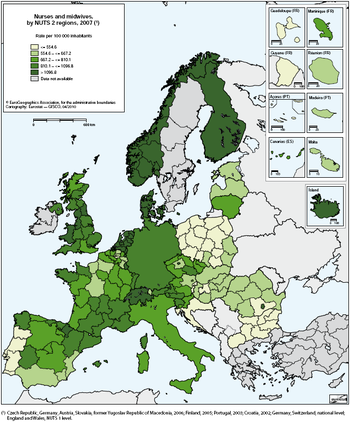Archive:Healthcare staff statistics at regional level
This Statistics Explained article is outdated and has been archived - for recent articles on health see here.
- Data from March 2010. Most recent data: Further Eurostat information, Main tables and Database.
This article presents data on the numbers of healthcare staff (doctors, dentists and other health professionals) in the European Union (EU), at a regional level.
Human resources in healthcare are a major indicator of the way in which healthcare is provided to the population and can help to evaluate the success of public health policies. Regional data offer a very detailed view on human resources in healthcare.
Main statistical findings
At EU level, Europe can roughly be divided into two distinct areas by drawing a line from Finland to Italy. West of this line, healthcare systems can generally count on between 667 and 1 096 nursing professionals per 100 000 inhabitants, with the notable exception of Portugal, whereas regions in the east often have an indicator of below 667 per 100 000 inhabitants, with some even below 554.
In 2007 the average number of nurses and midwives per 100 000 inhabitants was around 882 for the EU-27. The highest concentration of practising nurses and midwives per 100 000 inhabitants was reported by Luxembourg (1 571.5), followed by the Netherlands (1 500.7), Switzerland (1 485.7), Iceland (1 460.1) and Denmark (1 459.3), whereas in Bulgaria the figure of 466.4 was around 53 % lower than the EU average.
In other words, considerable variations can be observed at regional level.
Across all regions the density ranges from fewer than 300 in several regions of Portugal (Algarve, Alentejo and Norte) to higher than 1 600 in the Netherlands (Gelderland, Zeeland, Groningen, Friesland and Drenthe). Not surprisingly, in most countries the highest concentration is often found in the capital region, for example Praha (Prague) or Bucureşti - Ilfov (Bucharest). However, in a number of countries non-capital regions also have a high proportion of nurses and midwives, for example, Limousin in France, Prov. West-Vlaanderen in Belgium or Comunidad Foral de Navarra and Aragon in Spain.
When interpreting the map, special attention has to be paid to the fact that the regional data for France, Italy, Slovakia and the former Yugoslav Republic of Macedonia are for 'professionally active' nurses and midwives (which include practising and other (non-practising) midwives and nurses for whom their training is a prerequisite for the job), and could therefore be overestimated.
Data sources and availability
Regional data on healthcare staff give a broad picture of the human resources available to provide healthcare for the population. Eurostat’s information on healthcare staff is largely based on administrative sources. The definitions used possibly vary from one country to another and, to a large degree, reflect countries’ specific ways of organising healthcare, so the data collected are not always completely comparable.
The data presented on human resources available to provide healthcare services take no account of the sector of employment (i.e. whether the staff are independent or are employed by a hospital or any other provider). For the purpose of comparing healthcare services across Member States, Eurostat prefers the concept of ‘practising professionals’, as this gives the best picture of the availability of healthcare resources (although this was not always possible to achieve).
Eurostat collects regional-level statistics on healthcare staff (numbers of doctors, dentists and other health professionals) and on hospital beds as well as data on hospital discharges of in-patients (the latter two are not shown in this publication but are available in Eurostat’s statistical databases, see #Database). In addition to absolute numbers, density rates are provided for healthcare statistics. Density rates are used to describe the availability of these resources or the frequency of services rendered, expressed per 100 000 inhabitants. They are calculated by dividing the absolute number of healthcare resources available or services rendered in a given period by the respective population in the same period and then multiplying it by 100 000.
Context
Health is a top priority for Europeans, who expect to be protected against illness and disease — at home, at work and when travelling. The issue cuts across a range of topics from consumer protection (food safety) to safety at work and environmental and social policies.
Establishment of comparable EU-wide data on public health and the factors determining is closely linked to one of the priorities of the community action programme in the field of public health 2008–13, namely to generate and disseminate health information and knowledge on health.
This enables Eurostat to contribute to achieving other objectives of the action programme, by collecting and disseminating statistics and health indicators which help policymakers to identify health risks, improve public health security and promote health, including reducing health inequalities.
Information about healthcare systems and, ultimately, about the health of a population is a prerequisite for monitoring the performance of health policy.
The regional indicators currently available for health provide an insight into similarities, particularities and contrasts across regions in Europe. As explained above, there can be big differences between regions in the same country, while regions in different countries may be very similar. Thorough analysis of trends and variations in health indicators at regional level is therefore indispensable for planning and monitoring action and programmes, formulating new policies, developing new strategies and, all in all, contributing to ‘evidence-based health policy’.
Eurostat’s work on health statistics is focusing mainly on further improvements in the quality, comparability and completeness of the data and further extension of the regional coverage.
Further Eurostat information
Publications
Main tables
- Health, see
- Public health
- Main tables
- Health care: resources and patients (non-expenditure data)
Database
- Health, see
- Public health
- Database
- Health care: resources and patients (non-expenditure data)
- Database
Other information
External links
- European Commission - Health - Developing health indicators and data collection
- WHO - Health statistics and health information systems
